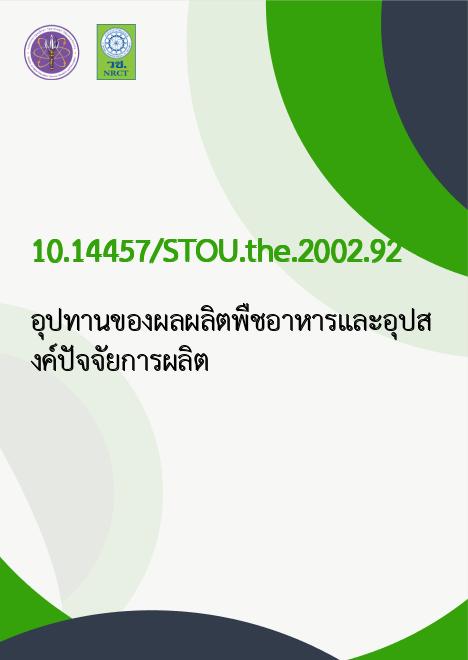
|
อุปทานของผลผลิตพืชอาหารและอุปสงค์ปัจจัยการผลิต |
|---|---|
| รหัสดีโอไอ | |
| Title | อุปทานของผลผลิตพืชอาหารและอุปสงค์ปัจจัยการผลิต |
| Creator | ภาสิตา ลีเกษม |
| Publisher | มหาวิทยาลัยสุโขทัยธรรมาธิราช |
| Publication Year | 2545 |
| Keyword | พืชอาหาร |
| Abstract | งานวิจัยที่ผ่านมาเกี่ยวกับอุปทานของผลผลิตพืชอาหารและอุปสงค์ของปัจจัยการผลิตเป็นการศึกษาวิเคราะห์พืชเกษตรชนิดเดียวโดยใช้แบบจำลองพืชผลชนิดเดียวที่มีข้อสมมติให้สิ่งอื่น ๆ คงที่ ซึ่งไม่สอดคล้องกับพฤติกรรมการผลิตที่เกษตรกรตัดสินใจเลือกผลิตพืชหลายชนิด ทำให้ข้อสรุปที่ได้อาจจะไม่สามารถสะท้อนภาวะการตัดสินใจและพฤติกรรมการผลิตของเกษตรกรได้แม่นยำนักทำให้นัยนโยบายการเกษตรลดความน่าเชื่อถือลง การวิจัยครั้งนี้จึงมีวัตถุประสงค์เพื่อที่จะสร้างและวิเคราะห์แบบจำลองของอุปทานของพืชอาหารและอุปสงค์ของปัจจัยการผลิตของพืชหลายชนิดและเพื่อศึกษาวิเคราะห์ความสัมพันธ์ของปัจจัยกำหนดการผลิตพืชอาหารและการใช้ปัจจัยการผลิต การวิจัยครั้งนี้ใช้แนวคิดการหากำไรสูงสุดของผู้ผลิต ทฤษฎีคู่ และแบบจำลองสมการกำไรทางคณิตศาสตร์แบบทั่วไปของลีอองเทียฟโดยใช้วิธีประมาณค่าสัมประสิทธิ์ของแบบจำลองสมการการถดถอยที่ดูเหมือนไม่เกี่ยวข้องกัน และใช้วิธีการประมาณค่าด้วยระบบสมการ ขอบข่ายการศึกษาจำกัดเฉพาะถั่วเขียว ถั่วเหลือง และถั่วลิสง และปัจจัยการผลิตคือแรงงานคน แรงงานสัตว์ แรงงานเครื่องจักร ปุ๋ยและสารเคมี ช่วงเวลาของข้อมูลที่ใช้ศึกษาอยู่ระหว่างปี 2530/31 -2544/45 ผลการวิจัยพบว่าแบบจำลองระบบสมการมีนัยสำคัญทางสถิติที่ระดับความเชื่อมั่นร้อยละ 95 ในขณะที่อุปทานพบว่าถั่วเหลืองกับถั่วลิสงเป็นพืชแข่งขันกันแต่อิทธิพลของราคาถั่วเหลืองสูงกว่าถั่วลิสง ส่วนด้านอุปสงค์ปัจจัยการผลิตพบว่าแรงงานคนเป็นปัจจัยใช้ร่วมกับแรงงานสัตว์แต่แข่งขันกับการใช้เครื่องจักร ส่วนปุ๋ยและสารเคมีเป็นปัจจัยแข่งขันกันบางส่วน นอกจากนี้ตัวแปรพื้นที่ เทคโนโลยีมีนัยสำคัญทางสถิติที่ระดับความเชื่อมั่นร้อยละ 95% การศึกษาครั้งนี้สามารถนำมาวิเคราะห์เพื่อให้ได้ความกระจ่างเกี่ยวกับความสัมพันธ์ระหว่างตัวแปรได้ในระดับหนึ่ง แต่เนื่องจากขีดจำกัดของข้อมูลจึงทำให้ต้องปรับลดขอบเขตของการศึกษา อนึ่งการวิเคราะห์จะมีความสมบูรณ์มากขึ้นหากมีการจัดทำฐานข้อมูลที่มีอยู่มาใช้ประโยชน์ให้ได้มากกว่านี้ ดังนั้นหน่วยงานที่รับผิดชอบดูแลข้อมูลพืชอาหารควรมีการปรับปรุงระบบฐานข้อมูลทั้งเชิงคุณภาพและปริมาณให้มีความครบถ้วนและสมบูรณ์มากขึ้นเพื่อทำให้ผลการวิจัยที่ได้สามารถนำไปใช้ประโยชน์ในการกำหนดนโยบายให้ดียิ่งขึ้น || Previous crop studies on the supply response of food crops and demand for factors of production havebeen mainly single crop studies which made assumptions that influence from other crops is held constant. Theseassumptions, however, may be inconsistent with the behaviours of farmers who generally may choose to plant morethan one crops simultaneously. As such single crop studies may have limitations in reflecting the context of decisionmaking and behaviorial responses of farmers thus reducing the degree of validity of the policy implications.The objectives of this study were to build an econometric model of supply response of food crops anddemand for factors of production, and to study the relationships among factors determining food crops productionand the use of factors of production.The conceptual framework of this study is based on maximizing profit behavior of farmers, duality theory,the Generalized Leontief Profit mathematical model. The methods of Seemingly Unrelated Estimation (SURE) andsystem of equations estimation were used as analytical tools. Target crops covered have been limited to mungbean,soybean and groundnuts. Factors of production considered in the model included labour saving machinery andagricultural equipment fertilizer and chemicals. Data used for the analysis were time series data of from 1987 to2001.The results showed that the parameters of equation system are statistically significant at 95% confidencelevel (p-value<0.05). The findings from supply equation system were that soybeans and groundnuts are substitutecrops and that the price effect of soybeans is greater than those of groundnuts. From the demand equation system,results confirmed that human labor and draft animal are complementary factors, but that human labour and laboursaving machinery are substitute factors. Fertilizer and chemicals were found to be substitute factors while area undercultivation and the adoption of technology were found to be positively related to output and statistically significant at95% confidence level (p-value<0.05).While the findings of this study can, to a certain extent, generate better understanding of the causalrelationship between prices and uses of factors of production among the target food crops, the limitations of the datahad made it necessary to reduce the scope of the study in terms of crops covered and the period of analysis. Theanalysis could however, be made much more comprehensive with better utilization of data and information availableat various implementing agencies. It is therefore recommended that the organizations that are responsible for cropdatabase should improve their database system so that they can be used to support more comprehensive studiessuch that are attempted by this research either by themselves or other interested researchers. This will ensure thatmore comprehensive results can be derived and hence greater policy relevance recommendations can be assured. |
| URL Website | https://repository.stou.ac.th |
| Website title | STOU Digital Repository |